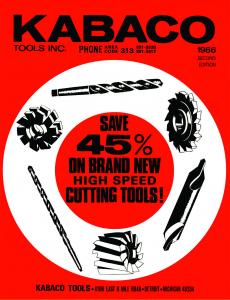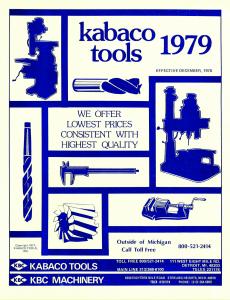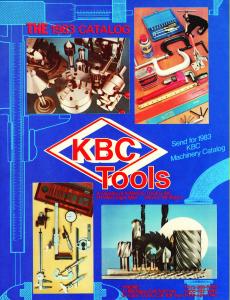Since 1965 to now KBC Tools & Machinery celebrates 60 years in business and innovation within the metalworking industry
2025 marks KBC’s 60th anniversary since Karel Bass started the ball rolling with a determination to sell the best tooling at the best prices.
STERLING HEIGHTS, MI, UNITED STATES, October 20, 2025 /EINPresswire.com/ -- 2025 marks KBC’s 60th anniversary since Karel Bass started the ball rolling with a determination to sell the best tooling at the best prices.In 1965 KBC, then Kabaco Tools, started out in 1,000 square foot warehouse on 8 Mile Road in Detroit, Michigan and now supplies North America from 6 branches in The U.S. and Canada. Over 100,000 industrial SKU’s from over 600 world class manufacturers, and still going strong 60 years later and keeping North America working one tool at a time.
Here's a list of fun facts that compare the metalworking industry from 1965 when KBC started to where we are now in 2025, highlighting the evolution and milestones over six decades:
1. Machines Then vs. Now
• 1965: The Bridgeport milling machine was a staple in every shop, operated manually.
• 2025: CNC machines dominate the industry, capable of running 24/7 with minimal human intervention, but clients still love their manual milling machines.
2. Workforce Evolution
• 1965: The metalworking industry was predominantly male-dominated, with women comprising less than 5% of the workforce.
• 2025: Women make up over 30% of the workforce, and companies like KBC Tools & Machinery proudly lead the way as women-owned businesses.
3. Precision Advancements
• 1965: Tolerances of ±0.001 inches were considered precise.
• 2025: Modern machining allows for tolerances as tight as ±0.0001 inches, driven by advancements in technology and materials.
4. Tooling Technology
• 1965: High-speed steel (HSS) tools were the go-to for most cutting tasks.
• 2025: Carbide, ceramic, and even diamond-coated tools are standard, offering far superior performance and longevity, while HSS is still a standard.
5. Manufacturing Speed
• 1965: A single part might take hours or even days to produce, depending on complexity.
• 2025: Additive manufacturing (3D printing) and CNC machines can produce complex parts in a matter of minutes, directly from a digital file.
6. Safety Standards
• 1965: Safety gear was minimal—think goggles and maybe gloves. Heck, who even used the seatbelt in their car?
• 2025: Full personal protective equipment (PPE), including advanced sensors and monitoring systems, ensures workers' safety. Better safe than sorry.
7. Material Science
• 1965: Steel and aluminum were the primary materials in use.
• 2025: Titanium, carbon fiber, and advanced composites are commonly used, offering superior strength-to-weight ratios.
8. Environmental Impact
• 1965: Waste disposal was not heavily regulated, and environmental impact was often an afterthought.
• 2025: The industry is committed to sustainability, with recycling programs and eco-friendly lubricants like Anchorlube.
9. Data-Driven Manufacturing
• 1965: Machine settings and adjustments were based on operator experience and manual calculations, and any data available was hand written into a paper log book.
• 2025: Real-time data analytics from SPC enabled measuring tools, CNC equipment and AI-driven systems optimize every aspect of production, from material usage to machine performance, like precision instruments from Mitutoyo and Fowler.
10. Global Connectivity
• 1965: Communication was limited to phone calls, faxes, telex, and in-person meetings.
• 2025: Global teams collaborate in real-time through digital platforms, with remote monitoring and control of machines from anywhere in the world.
11. Education & Training
• 1965: Apprenticeships and hands-on learning were the primary methods of training.
• 2025: Virtual reality (VR) and online simulations allow machinists to train in a risk-free, immersive environment before stepping onto the shop floor. Are hologram trainers on the shop floor far behind?
12. Industry 4.0
• 1965: The concept of automation was in its infancy, with basic NC (Numerical Control) machines. Can you remember computer programs driven by boxes of punch cards?
• 2025: Industry 4.0 is fully integrated, with smart factories, IoT-connected devices, and digital twins for real-time production optimization.
13. Quality Control
• 1965: Quality checks were manual, with inspectors using micrometers and calipers.
• 2025: Automated, non-contact measurement systems like laser scanners and CMMs (Coordinate Measuring Machines) ensure precision with zero human error, while manual inspection methods using digital micrometers and calipers are now equipped with SPC output. Who can even read a vernier caliper that is under 55 years old?
14. Cutting Fluids
• 1965: Standard cutting oils were messy and often harmful to the environment.
• 2025: Modern cutting fluids like Anchorlube are biodegradable, non-toxic, and much more efficient at reducing heat and friction.
15. Industry Perception
• 1965: Metalworking was viewed as a gritty, blue-collar job with limited growth opportunities.
• 2025: The industry is seen as high-tech and innovative, offering exciting career paths in robotics, engineering, and advanced manufacturing.
These fun facts showcase how the metalworking industry has transformed dramatically over the past 60 years, embracing technology, diversity, and sustainability while continuing to innovate and grow. KBC Tools & Machinery has also come a long way since 1965 with a greatly expanded and technically updated offering of products for the modern machine shop. Whether a manual or CNC facility or any type of MRO work for industry, KBC has what's needed from HSS drill bits and end mills to indexable cutting tools, from manual machines to CNC equipment.
Many, many thanks to all of our clients, KBC Team Members, and world class manufacturers for their support and continued business since 1965.
KBC Tools & Machinery has been providing the metalworking industry with the best tools at the best prices since 1965: cutting tools, indexable tooling, fluids, work holding, abrasives, measuring & inspection equipment, toolroom accessories, hand tools, shop supplies, power & air tools, and machinery. KBC is proud to be certified as a WBE company in Canada and a WBENC company in The USA. KBC is one of the leading metal cutting tool and machinery catalogue houses in North America with 3 locations complete with showroom in Canada: Mississauga, ON; Oldcastle, ON; and Delta, BC; and 4 locations in The U.S.A.: Sterling Heights, MI; Sterling Heights, MI Machinery Showroom; Elk Grove Village, IL; and Fullerton, CA; KBC Tools & Machinery – www.kbctools.com - All Metal…All The Time!
PAULA BASS
KBC TOOLS & MACHINERY
+1 905-564-6600
email us here
Visit us on social media:
LinkedIn
Instagram
Facebook
Legal Disclaimer:
EIN Presswire provides this news content "as is" without warranty of any kind. We do not accept any responsibility or liability for the accuracy, content, images, videos, licenses, completeness, legality, or reliability of the information contained in this article. If you have any complaints or copyright issues related to this article, kindly contact the author above.



